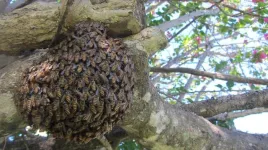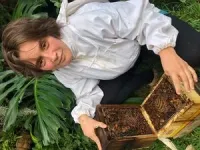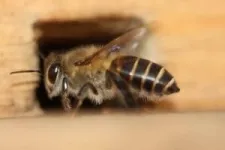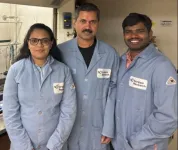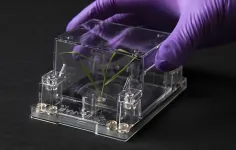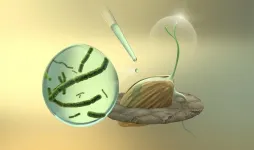(Press-News.org) For more than a decade, invasive Asian honeybees have defied evolutionary expectations and established a thriving population in North Queensland, much to the annoyance of the honey industry and biosecurity officials.
Research published today in Current Biology has shown the species, Apis cerana, has overcome what is known as a genetic bottleneck to grow from a single swarm into a population of more than 10,000 colonies over a 10,000 square kilometre area – which is about the size of Greater Sydney.
Co-lead author Dr Rosalyn Gloag from the University of Sydney School of Life and Environmental Sciences said: “Our study of this bee population shows that some species can quickly adjust to new environments despite starting with very low genetic diversity relative to their native-range populations.”
Dr Gloag said that high genetic diversity is generally assumed to be important for a population to quickly adapt to changing environmental conditions, such as when a species is translocated or experiences rapid environmental change caused by natural or climate change disasters.
“However, we have shown that this invasive population of honeybees has rapidly adapted since its arrival, despite having suffered a steep loss in genetic diversity,” she said.
The research team highlight the importance of this case study for understanding population resilience in general.
“This is even more important as we observe many species dealing with anthropogenic climate change,” Dr Gloag said.
Studying the invasive population in Queensland gave the research team a rare complete genetic timeline of a natural invasion, beginning from soon after the bees arrived.
The arrival of the colony in 2007, likely from Papua New Guinea, was of concern to Australian biosecurity because of the parasites the bees can carry. Ultimately these bees were found not to be carrying the most feared of its parasites, the varroa mite, which has since arrived in Australia by an unknown route, threatening the domestic honey industry.
“We were lucky to have a complete sample timeline of this invasive population thanks to the incredible efforts of the Queensland Department of Agriculture and Fisheries, which sampled the population extensively during the early years of the incursion as part of an eradication attempt,” Dr Gloag said.
“Although that attempt was unsuccessful, the biological material collected has been incredibly valuable for understanding how these invasions proceed. And that in turn helps us prepare better for future invasions,” she said.
Access to this comprehensive sample set allowed the scientists to re-sequence entire genomes of 118 individual bees collected over 10 years.
“We could essentially observe natural selection acting over time in a population that started with low genetic diversity,” Dr Gloag said. “From this unique vantage point, we could see that selection was acting on the variation in genomes that had arrived with the handful of original bees. It wasn’t variation that arose later by mutations.
“In other words, some species with very low genetic diversity can adapt very quickly,” she said.
“While this might be bad news for environments coping with newly arrived invasive species, it’s potentially good news for populations that have temporary crashes in the face of climate change or other natural or human-induced disasters, such as bushfires.”
The study was done in collaboration with scientists at York University (Canada), IPB University (Indonesia), Bandung Institute of Technology (Indonesia) and the CSIRO (Australia).
DOWNLOAD research, images and videos of the bees at this link.
INTERVIEWS
Dr Ros Gloag | ros.gloag@sydney.edu.au
School of Life and Environmental Sciences | The University of Sydney
MEDIA ENQUIRIES
Marcus Strom | The University of Sydney | marcus.strom@sydney.edu.au | +61 474 269 459
RESEARCH
Dogantzis, K, Gloag, R, et al (2024) ‘Post-invasion selection acts on standing genetic variation despite a severe founding bottleneck’ Current Biology DOI: 10.1016/j.cub.2024.02.010
DECLARATION
The authors declare no competing interests. Research was conducted with assistance from the Australian Research Council, the Natural Sciences and Engineering Research Council (Canada) and the Ministry of Research, Technology and Higher Education (Indonesia).
END
Bottlenecks and beehives: how an invasive bee colony defied genetic expectations
Adaptability despite low genetic diversity could be a good sign for threatened species
2024-02-29
ELSE PRESS RELEASES FROM THIS DATE:
Climate: 2023 – 24 El Niño likely to cause record-breaking average temperatures in some areas
2024-02-29
Several areas of the globe — including the Bay of Bengal, the Philippines, and the Caribbean Sea — are likely to experience record-breaking average surface air temperatures in the year period up to June 2024 as a result of the ongoing El Niño phenomenon. The modelling results, published in Scientific Reports, also suggest that there is an estimated 90 percent chance of record-breaking global mean surface temperatures occurring over the same period under a moderate or strong El Niño scenario.
The El Niño-Southern Oscillation, centred ...
Disparities in patient portal use among adults with chronic conditions
2024-02-29
About The Study: This study of 536 participants identified changes in patient portal use over time and highlighted populations that had lower access to health information. The COVID-19 pandemic was associated with an increase in portal use. Sociodemographic disparities by sex and age were reduced, although disparities by health literacy widened. A brief validated health literacy measure may serve as a useful digital literacy screening tool to identify patients who need further support.
Authors: Esther Yoon, Ph.D., M.P.H., M.S., of Northwestern University in Chicago, is the corresponding ...
Factors associated with racial and ethnic disparities in locally advanced rectal cancer outcomes
2024-02-29
About The Study: The findings of this study of 34,500 patients suggest that racial and ethnic disparities in locally advanced rectal cancer treatment outcomes may be multifactorial, with an independent association with non-Hispanic Black race, suggesting unidentified biological variables or social determinants of health that warrant exploration.
Authors: Sanjeevani Arora, Ph.D., and Shannon M. Lynch, Ph.D., M.P.H., of the Fox Chase Cancer Center in Philadelphia, are the corresponding authors.
To access the embargoed study: Visit our For The Media website at this link https://media.jamanetwork.com/
(doi:10.1001/jamanetworkopen.2024.0044)
Editor’s ...
CZI announces multi-institutional collaborations for tech to better understand cells
2024-02-29
Today, the Chan Zuckerberg Initiative (CZI) announced four multi-year grants that will bring together regional labs in California, the Mid-Atlantic, and the Research Triangle in North Carolina to explore the frontiers of genomics, cell biology, and synthetic biology by developing new measurement technologies. These projects will focus on developing technologies to engineer cell and tissue models, exploring cellular responses to genetic and environmental stressors, understanding RNA's role in metabolism, and more.
“To unravel the mysteries of the cell, we need new technologies, and the Exploratory Cell Networks grants support early-stage ...
Researchers uncover key therapeutic target involved in diabetic atherosclerosis
2024-02-29
Diabetes accelerates the development of atherosclerosis, increasing the incidence of cardiovascular events. In atherosclerosis, immune cells called macrophages release molecules such as chemokines and cytokines, causing inflammation and leading to arterial plaque formation. However, significant gaps persist in understanding the exact molecular mechanisms controlling this increased inflammatory response in individuals with diabetes. In a new, preclinical study, researchers from Brigham and Women’s Hospital, a founding member of the Mass General Brigham healthcare system, identified a long non-coding RNA (lncRNA) sequence that could help them unravel the ...
Scripps Research scientists reveal how first cells could have formed on Earth
2024-02-29
LA JOLLA, CA—Roughly 4 billion years ago, Earth was developing conditions suitable for life. Origin-of-life scientists often wonder if the type of chemistry found on the early Earth was similar to what life requires today. They know that spherical collections of fats, called protocells, were the precursor to cells during this emergence of life. But how did simple protocells first arise and diversify to eventually lead to life on Earth?
Now, Scripps Research scientists have discovered one plausible pathway for how protocells may have first formed and chemically ...
EcoFABs could lead to better bioenergy crops
2024-02-29
– By Will Ferguson
A greater understanding of how plants and microbes work together to store vast amounts of atmospheric carbon in the soil will help in the design of better bioenergy crops for the fight against climate change.
Deciphering the mechanics of this mutually beneficial relationship is challenging, however, as conditions in nature are extremely difficult for scientists to replicate in the laboratory. To address this challenge, researchers at Lawrence Berkeley National Laboratory (Berkeley Lab) created fabricated ecosystems or EcoFABs.
In a new paper in Science Advances, they ...
Digital Science announces Catalyst Grant winners, supporting AI-based innovations to benefit research
2024-02-29
Digital Science has awarded two new Catalyst Grants of £25,000 each to innovative AI-based technology ideas aimed at advancing global research.
The winners will use the funding to develop their ideas, which include using AI to alleviate the burden on researchers of applying for research funding, and to predict research impact.
The winning applications from Digital Science’s 2023 Catalyst Grant round announced today are:
Atom – Tomer du Sautoy (co-founder and CEO) and Hamilton Evans (co-founder and ...
Targeting seed microbes to improve seed resilience
2024-02-29
Fonio (Digitaria exilis), a type of millet, is the oldest indigenous crop in West Africa and one of the fastest maturing cereals. Despite its low yield, the combination of quick maturation and drought tolerance and its ability to thrive in poor soils make it a useful model for understanding how cereals can adapt to future climate change conditions.
Nutritionally, fonio is comparable to other millets, says KAUST researcher Naheed Tabassum, but yields are much lower than the major cereal crops rice, maize and wheat. Tabassum believes fonio could complement staple crops amid climate change and desertification ...
Astronomers discover heavy elements after bright gamma-ray burst from neutron star merger
2024-02-29
An international team of astronomers — including Clemson University astrophysicist Dieter Hartmann — obtained observational evidence for the creation of rare heavy elements in the aftermath of a cataclysmic explosion triggered by the merger of two neutron stars.
The massive explosion unleashed a gamma-ray burst, GRB230307A, the second brightest in 50 years of observations and about 1,000 times brighter than a typical gamma-ray burst. GRB230307A was first detected by NASA’s Fermi Gamma-Ray Space Telescope on March 7, 2023.
Using multiple space- and ground-based ...
LAST 30 PRESS RELEASES:
UN University Report challenges climate change as sole trigger of Syrian Civil War, exposing governance failures in drought response
Real estate investment trust (REIT) acquisition associated with hospital closure and bankruptcy
New Raman imaging system detects subtle tumor signals
Boston Children’s receives a $7.5 million grant from Aligning Research to Impact Autism (ARIA) to provide clinical research coordination for the IMPACT Network
Spray-on antibacterial coating offers new protection for plants against disease and drought
ESMT Berlin study: What makes a first offer successful in negotiations
Groundbreaking ceremony marks the beginning of CTAO-South Array construction in Chile
Why swearing makes you stronger
What prevents more cancer patients from enrolling in potentially life-saving clinical trials?
UK’s worst-case climate risks laid bare for lawmakers
A decline in churchgoing linked to more deaths of despair
TAMEST announces Maralice Conacci-Sorrell, Ph.D., UT Southwestern Medical Center, as 2026 Mary Beth Maddox Award & Lectureship Recipient
Global study to evaluate whether dengue outbreaks can be anticipated earlier
Chonnam National University researchers propose innovative voltage-loop control for power factor correction
Accelerating next-generation drug discovery with click-based construction of PROTACs
Detecting the hidden magnetism of altermagnets
$7M gift supports health research, engineering and athletics at UT San Antonio
NU-9 halts Alzheimer’s disease in animal model before symptoms begin
Hospitals acquired by real estate investment trusts associated with greater risk of bankruptcy, closure
City of Hope scientists study rare disorder to uncover mechanism and hormone regulation underlying fatty liver disease and sweet aversion
Your genes may influence gut microbiome of others, rat study shows
‘Personality test’ shows how AI chatbots mimic human traits – and how they can be manipulated
Global food systems driving twin crises of obesity and global heating
Osaka Medical and Pharmaceutical University researchers capture real-time molecular movies of enzyme catalysis
Could your genes influence the gut microbiome of others?
Clues to Alzheimer’s disease may be hiding in our ‘junk’ DNA
Study reveals that the body uses different sensors to detect cold in the skin and in internal organs
iPS cells from dish to freezer and back
Deep neural networks enable accurate pricing of American options under stochastic volatility
Collective risk resonance in Chinese stock sectors uncovered through higher-order network analysis
[Press-News.org] Bottlenecks and beehives: how an invasive bee colony defied genetic expectationsAdaptability despite low genetic diversity could be a good sign for threatened species
